University Report: Pertussis Outbreak Control Strategies and Analysis
VerifiedAdded on 2020/03/23
|11
|3010
|54
Report
AI Summary
This report addresses the resurgence of pertussis (whooping cough), a concerning trend in recent years, particularly in regions with high vaccination coverage like New South Wales, Australia. The study investigates the reasons behind the outbreaks, including the effectiveness of acellular vaccines compared to whole cell vaccines, and the potential for bacterial mutation. It examines the notification rates across different age groups, highlighting the high incidence among adolescents and infants too young for vaccination. The report delves into the strategies for outbreak control, such as increased public awareness, changes in vaccine regimens (including booster shots), and antenatal vaccination programs. It also discusses the importance of educating healthcare staff and the public about symptoms, isolation, and the cocooning strategy. The conclusion underscores the need for effective public health measures, including the introduction of a pertussis vaccine to pregnant mothers during the third trimester and booster doses for adults who care for infants. The report emphasizes the importance of ongoing research and the development of new vaccines to provide long-lasting immunity and reduce the disease burden.
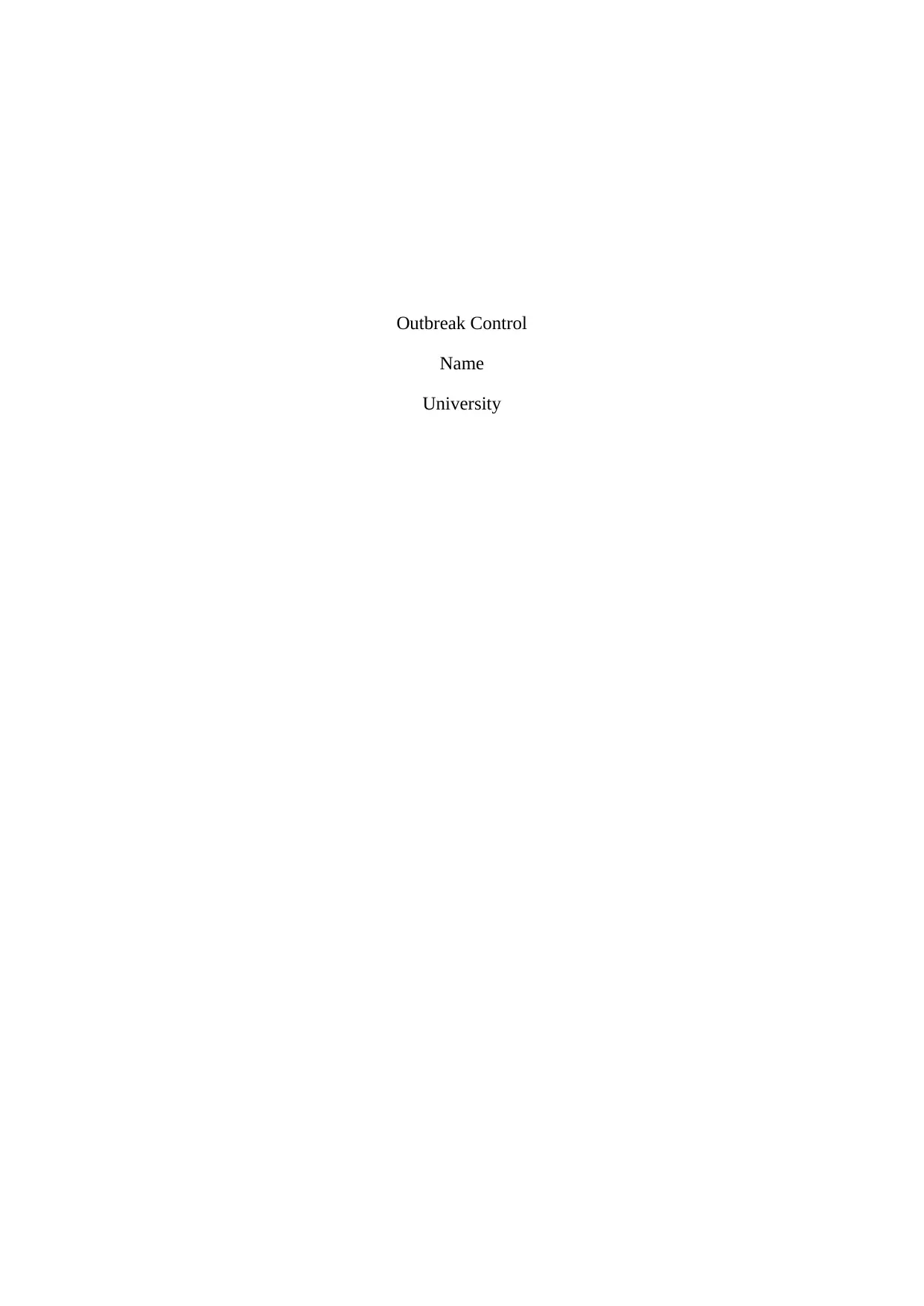
Outbreak Control
Name
University
Name
University
Paraphrase This Document
Need a fresh take? Get an instant paraphrase of this document with our AI Paraphraser
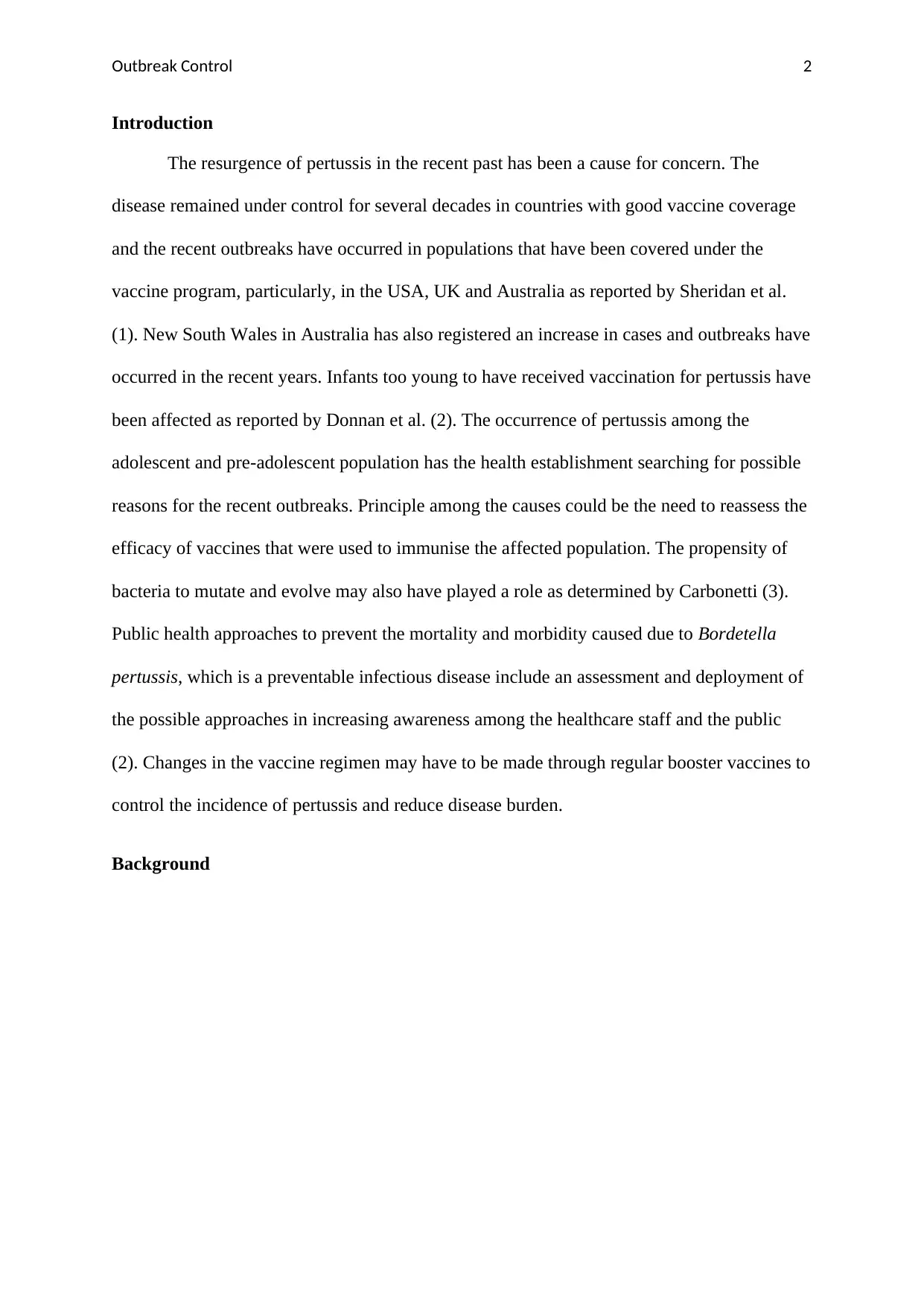
Outbreak Control 2
Introduction
The resurgence of pertussis in the recent past has been a cause for concern. The
disease remained under control for several decades in countries with good vaccine coverage
and the recent outbreaks have occurred in populations that have been covered under the
vaccine program, particularly, in the USA, UK and Australia as reported by Sheridan et al.
(1). New South Wales in Australia has also registered an increase in cases and outbreaks have
occurred in the recent years. Infants too young to have received vaccination for pertussis have
been affected as reported by Donnan et al. (2). The occurrence of pertussis among the
adolescent and pre-adolescent population has the health establishment searching for possible
reasons for the recent outbreaks. Principle among the causes could be the need to reassess the
efficacy of vaccines that were used to immunise the affected population. The propensity of
bacteria to mutate and evolve may also have played a role as determined by Carbonetti (3).
Public health approaches to prevent the mortality and morbidity caused due to Bordetella
pertussis, which is a preventable infectious disease include an assessment and deployment of
the possible approaches in increasing awareness among the healthcare staff and the public
(2). Changes in the vaccine regimen may have to be made through regular booster vaccines to
control the incidence of pertussis and reduce disease burden.
Background
Introduction
The resurgence of pertussis in the recent past has been a cause for concern. The
disease remained under control for several decades in countries with good vaccine coverage
and the recent outbreaks have occurred in populations that have been covered under the
vaccine program, particularly, in the USA, UK and Australia as reported by Sheridan et al.
(1). New South Wales in Australia has also registered an increase in cases and outbreaks have
occurred in the recent years. Infants too young to have received vaccination for pertussis have
been affected as reported by Donnan et al. (2). The occurrence of pertussis among the
adolescent and pre-adolescent population has the health establishment searching for possible
reasons for the recent outbreaks. Principle among the causes could be the need to reassess the
efficacy of vaccines that were used to immunise the affected population. The propensity of
bacteria to mutate and evolve may also have played a role as determined by Carbonetti (3).
Public health approaches to prevent the mortality and morbidity caused due to Bordetella
pertussis, which is a preventable infectious disease include an assessment and deployment of
the possible approaches in increasing awareness among the healthcare staff and the public
(2). Changes in the vaccine regimen may have to be made through regular booster vaccines to
control the incidence of pertussis and reduce disease burden.
Background
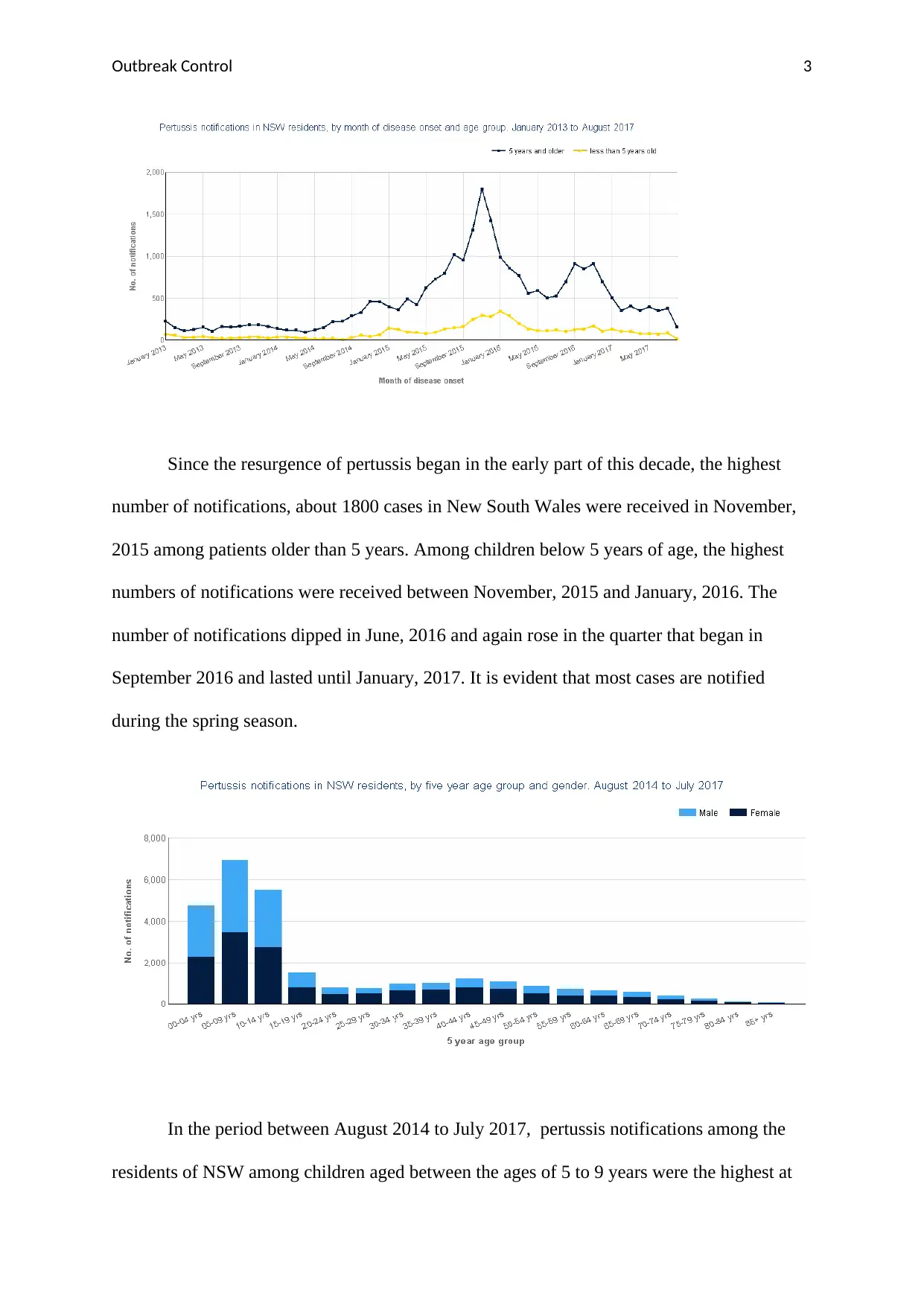
Outbreak Control 3
Since the resurgence of pertussis began in the early part of this decade, the highest
number of notifications, about 1800 cases in New South Wales were received in November,
2015 among patients older than 5 years. Among children below 5 years of age, the highest
numbers of notifications were received between November, 2015 and January, 2016. The
number of notifications dipped in June, 2016 and again rose in the quarter that began in
September 2016 and lasted until January, 2017. It is evident that most cases are notified
during the spring season.
In the period between August 2014 to July 2017, pertussis notifications among the
residents of NSW among children aged between the ages of 5 to 9 years were the highest at
Since the resurgence of pertussis began in the early part of this decade, the highest
number of notifications, about 1800 cases in New South Wales were received in November,
2015 among patients older than 5 years. Among children below 5 years of age, the highest
numbers of notifications were received between November, 2015 and January, 2016. The
number of notifications dipped in June, 2016 and again rose in the quarter that began in
September 2016 and lasted until January, 2017. It is evident that most cases are notified
during the spring season.
In the period between August 2014 to July 2017, pertussis notifications among the
residents of NSW among children aged between the ages of 5 to 9 years were the highest at
⊘ This is a preview!⊘
Do you want full access?
Subscribe today to unlock all pages.

Trusted by 1+ million students worldwide
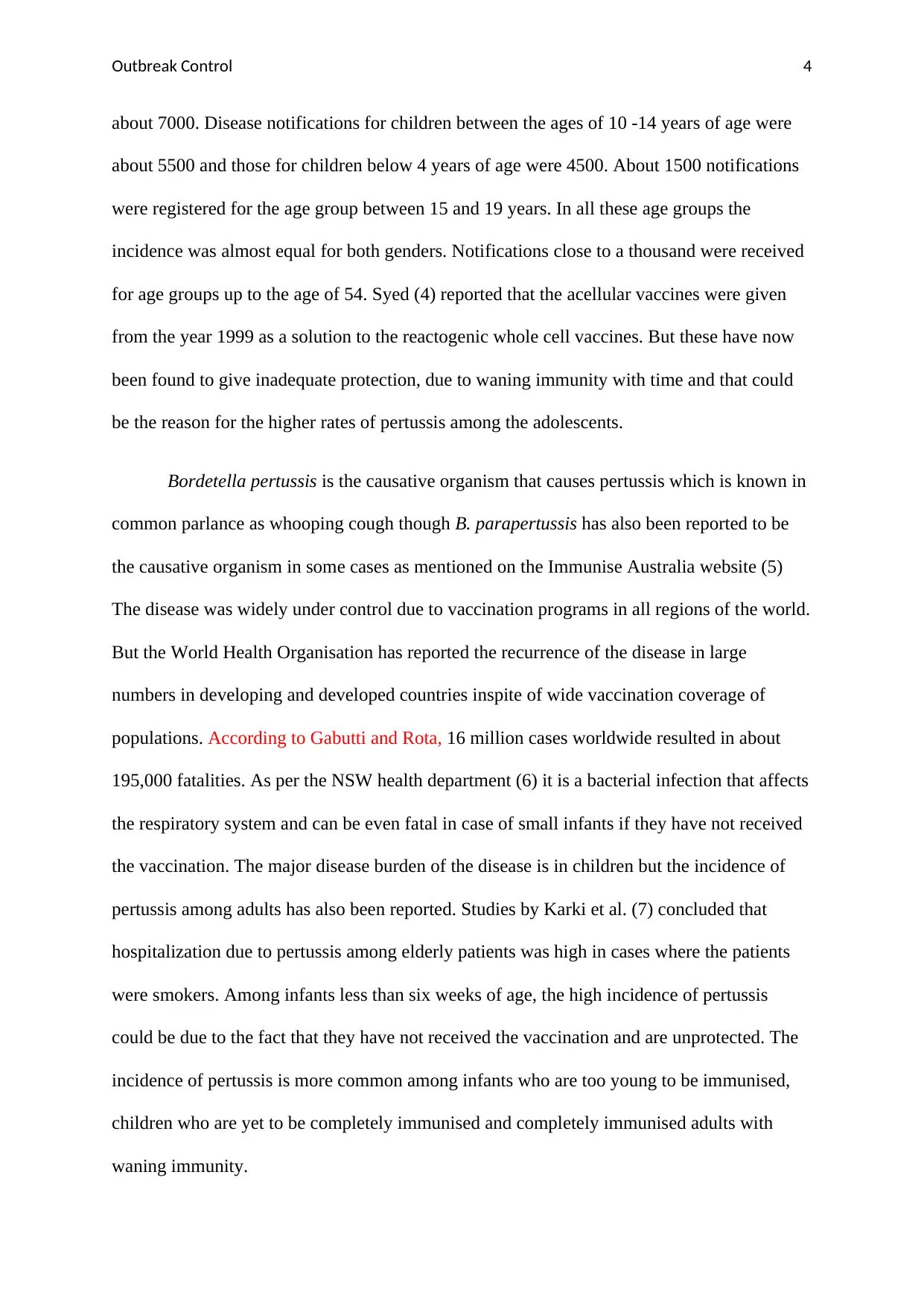
Outbreak Control 4
about 7000. Disease notifications for children between the ages of 10 -14 years of age were
about 5500 and those for children below 4 years of age were 4500. About 1500 notifications
were registered for the age group between 15 and 19 years. In all these age groups the
incidence was almost equal for both genders. Notifications close to a thousand were received
for age groups up to the age of 54. Syed (4) reported that the acellular vaccines were given
from the year 1999 as a solution to the reactogenic whole cell vaccines. But these have now
been found to give inadequate protection, due to waning immunity with time and that could
be the reason for the higher rates of pertussis among the adolescents.
Bordetella pertussis is the causative organism that causes pertussis which is known in
common parlance as whooping cough though B. parapertussis has also been reported to be
the causative organism in some cases as mentioned on the Immunise Australia website (5)
The disease was widely under control due to vaccination programs in all regions of the world.
But the World Health Organisation has reported the recurrence of the disease in large
numbers in developing and developed countries inspite of wide vaccination coverage of
populations. According to Gabutti and Rota, 16 million cases worldwide resulted in about
195,000 fatalities. As per the NSW health department (6) it is a bacterial infection that affects
the respiratory system and can be even fatal in case of small infants if they have not received
the vaccination. The major disease burden of the disease is in children but the incidence of
pertussis among adults has also been reported. Studies by Karki et al. (7) concluded that
hospitalization due to pertussis among elderly patients was high in cases where the patients
were smokers. Among infants less than six weeks of age, the high incidence of pertussis
could be due to the fact that they have not received the vaccination and are unprotected. The
incidence of pertussis is more common among infants who are too young to be immunised,
children who are yet to be completely immunised and completely immunised adults with
waning immunity.
about 7000. Disease notifications for children between the ages of 10 -14 years of age were
about 5500 and those for children below 4 years of age were 4500. About 1500 notifications
were registered for the age group between 15 and 19 years. In all these age groups the
incidence was almost equal for both genders. Notifications close to a thousand were received
for age groups up to the age of 54. Syed (4) reported that the acellular vaccines were given
from the year 1999 as a solution to the reactogenic whole cell vaccines. But these have now
been found to give inadequate protection, due to waning immunity with time and that could
be the reason for the higher rates of pertussis among the adolescents.
Bordetella pertussis is the causative organism that causes pertussis which is known in
common parlance as whooping cough though B. parapertussis has also been reported to be
the causative organism in some cases as mentioned on the Immunise Australia website (5)
The disease was widely under control due to vaccination programs in all regions of the world.
But the World Health Organisation has reported the recurrence of the disease in large
numbers in developing and developed countries inspite of wide vaccination coverage of
populations. According to Gabutti and Rota, 16 million cases worldwide resulted in about
195,000 fatalities. As per the NSW health department (6) it is a bacterial infection that affects
the respiratory system and can be even fatal in case of small infants if they have not received
the vaccination. The major disease burden of the disease is in children but the incidence of
pertussis among adults has also been reported. Studies by Karki et al. (7) concluded that
hospitalization due to pertussis among elderly patients was high in cases where the patients
were smokers. Among infants less than six weeks of age, the high incidence of pertussis
could be due to the fact that they have not received the vaccination and are unprotected. The
incidence of pertussis is more common among infants who are too young to be immunised,
children who are yet to be completely immunised and completely immunised adults with
waning immunity.
Paraphrase This Document
Need a fresh take? Get an instant paraphrase of this document with our AI Paraphraser
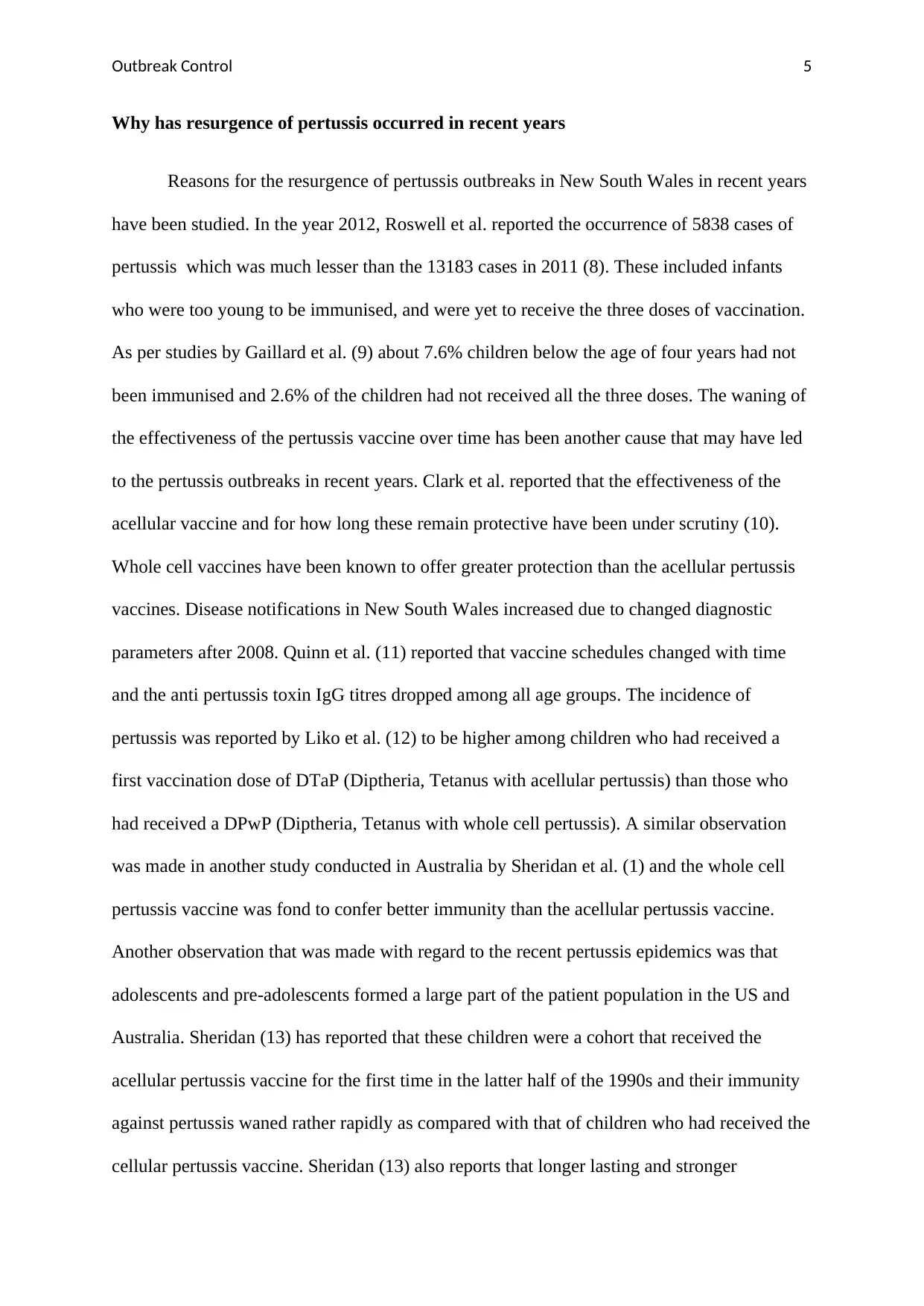
Outbreak Control 5
Why has resurgence of pertussis occurred in recent years
Reasons for the resurgence of pertussis outbreaks in New South Wales in recent years
have been studied. In the year 2012, Roswell et al. reported the occurrence of 5838 cases of
pertussis which was much lesser than the 13183 cases in 2011 (8). These included infants
who were too young to be immunised, and were yet to receive the three doses of vaccination.
As per studies by Gaillard et al. (9) about 7.6% children below the age of four years had not
been immunised and 2.6% of the children had not received all the three doses. The waning of
the effectiveness of the pertussis vaccine over time has been another cause that may have led
to the pertussis outbreaks in recent years. Clark et al. reported that the effectiveness of the
acellular vaccine and for how long these remain protective have been under scrutiny (10).
Whole cell vaccines have been known to offer greater protection than the acellular pertussis
vaccines. Disease notifications in New South Wales increased due to changed diagnostic
parameters after 2008. Quinn et al. (11) reported that vaccine schedules changed with time
and the anti pertussis toxin IgG titres dropped among all age groups. The incidence of
pertussis was reported by Liko et al. (12) to be higher among children who had received a
first vaccination dose of DTaP (Diptheria, Tetanus with acellular pertussis) than those who
had received a DPwP (Diptheria, Tetanus with whole cell pertussis). A similar observation
was made in another study conducted in Australia by Sheridan et al. (1) and the whole cell
pertussis vaccine was fond to confer better immunity than the acellular pertussis vaccine.
Another observation that was made with regard to the recent pertussis epidemics was that
adolescents and pre-adolescents formed a large part of the patient population in the US and
Australia. Sheridan (13) has reported that these children were a cohort that received the
acellular pertussis vaccine for the first time in the latter half of the 1990s and their immunity
against pertussis waned rather rapidly as compared with that of children who had received the
cellular pertussis vaccine. Sheridan (13) also reports that longer lasting and stronger
Why has resurgence of pertussis occurred in recent years
Reasons for the resurgence of pertussis outbreaks in New South Wales in recent years
have been studied. In the year 2012, Roswell et al. reported the occurrence of 5838 cases of
pertussis which was much lesser than the 13183 cases in 2011 (8). These included infants
who were too young to be immunised, and were yet to receive the three doses of vaccination.
As per studies by Gaillard et al. (9) about 7.6% children below the age of four years had not
been immunised and 2.6% of the children had not received all the three doses. The waning of
the effectiveness of the pertussis vaccine over time has been another cause that may have led
to the pertussis outbreaks in recent years. Clark et al. reported that the effectiveness of the
acellular vaccine and for how long these remain protective have been under scrutiny (10).
Whole cell vaccines have been known to offer greater protection than the acellular pertussis
vaccines. Disease notifications in New South Wales increased due to changed diagnostic
parameters after 2008. Quinn et al. (11) reported that vaccine schedules changed with time
and the anti pertussis toxin IgG titres dropped among all age groups. The incidence of
pertussis was reported by Liko et al. (12) to be higher among children who had received a
first vaccination dose of DTaP (Diptheria, Tetanus with acellular pertussis) than those who
had received a DPwP (Diptheria, Tetanus with whole cell pertussis). A similar observation
was made in another study conducted in Australia by Sheridan et al. (1) and the whole cell
pertussis vaccine was fond to confer better immunity than the acellular pertussis vaccine.
Another observation that was made with regard to the recent pertussis epidemics was that
adolescents and pre-adolescents formed a large part of the patient population in the US and
Australia. Sheridan (13) has reported that these children were a cohort that received the
acellular pertussis vaccine for the first time in the latter half of the 1990s and their immunity
against pertussis waned rather rapidly as compared with that of children who had received the
cellular pertussis vaccine. Sheridan (13) also reports that longer lasting and stronger
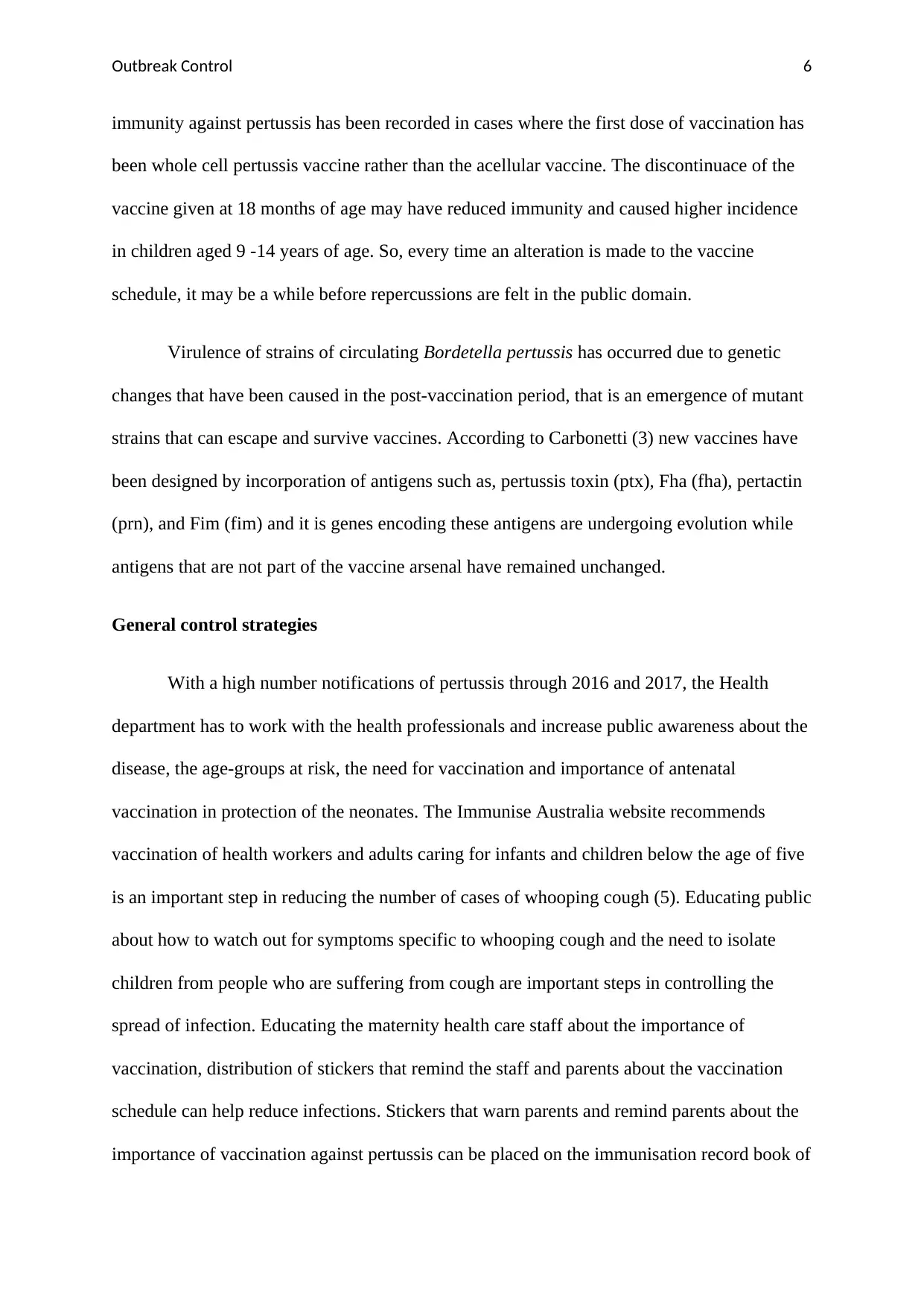
Outbreak Control 6
immunity against pertussis has been recorded in cases where the first dose of vaccination has
been whole cell pertussis vaccine rather than the acellular vaccine. The discontinuace of the
vaccine given at 18 months of age may have reduced immunity and caused higher incidence
in children aged 9 -14 years of age. So, every time an alteration is made to the vaccine
schedule, it may be a while before repercussions are felt in the public domain.
Virulence of strains of circulating Bordetella pertussis has occurred due to genetic
changes that have been caused in the post-vaccination period, that is an emergence of mutant
strains that can escape and survive vaccines. According to Carbonetti (3) new vaccines have
been designed by incorporation of antigens such as, pertussis toxin (ptx), Fha (fha), pertactin
(prn), and Fim (fim) and it is genes encoding these antigens are undergoing evolution while
antigens that are not part of the vaccine arsenal have remained unchanged.
General control strategies
With a high number notifications of pertussis through 2016 and 2017, the Health
department has to work with the health professionals and increase public awareness about the
disease, the age-groups at risk, the need for vaccination and importance of antenatal
vaccination in protection of the neonates. The Immunise Australia website recommends
vaccination of health workers and adults caring for infants and children below the age of five
is an important step in reducing the number of cases of whooping cough (5). Educating public
about how to watch out for symptoms specific to whooping cough and the need to isolate
children from people who are suffering from cough are important steps in controlling the
spread of infection. Educating the maternity health care staff about the importance of
vaccination, distribution of stickers that remind the staff and parents about the vaccination
schedule can help reduce infections. Stickers that warn parents and remind parents about the
importance of vaccination against pertussis can be placed on the immunisation record book of
immunity against pertussis has been recorded in cases where the first dose of vaccination has
been whole cell pertussis vaccine rather than the acellular vaccine. The discontinuace of the
vaccine given at 18 months of age may have reduced immunity and caused higher incidence
in children aged 9 -14 years of age. So, every time an alteration is made to the vaccine
schedule, it may be a while before repercussions are felt in the public domain.
Virulence of strains of circulating Bordetella pertussis has occurred due to genetic
changes that have been caused in the post-vaccination period, that is an emergence of mutant
strains that can escape and survive vaccines. According to Carbonetti (3) new vaccines have
been designed by incorporation of antigens such as, pertussis toxin (ptx), Fha (fha), pertactin
(prn), and Fim (fim) and it is genes encoding these antigens are undergoing evolution while
antigens that are not part of the vaccine arsenal have remained unchanged.
General control strategies
With a high number notifications of pertussis through 2016 and 2017, the Health
department has to work with the health professionals and increase public awareness about the
disease, the age-groups at risk, the need for vaccination and importance of antenatal
vaccination in protection of the neonates. The Immunise Australia website recommends
vaccination of health workers and adults caring for infants and children below the age of five
is an important step in reducing the number of cases of whooping cough (5). Educating public
about how to watch out for symptoms specific to whooping cough and the need to isolate
children from people who are suffering from cough are important steps in controlling the
spread of infection. Educating the maternity health care staff about the importance of
vaccination, distribution of stickers that remind the staff and parents about the vaccination
schedule can help reduce infections. Stickers that warn parents and remind parents about the
importance of vaccination against pertussis can be placed on the immunisation record book of
⊘ This is a preview!⊘
Do you want full access?
Subscribe today to unlock all pages.

Trusted by 1+ million students worldwide
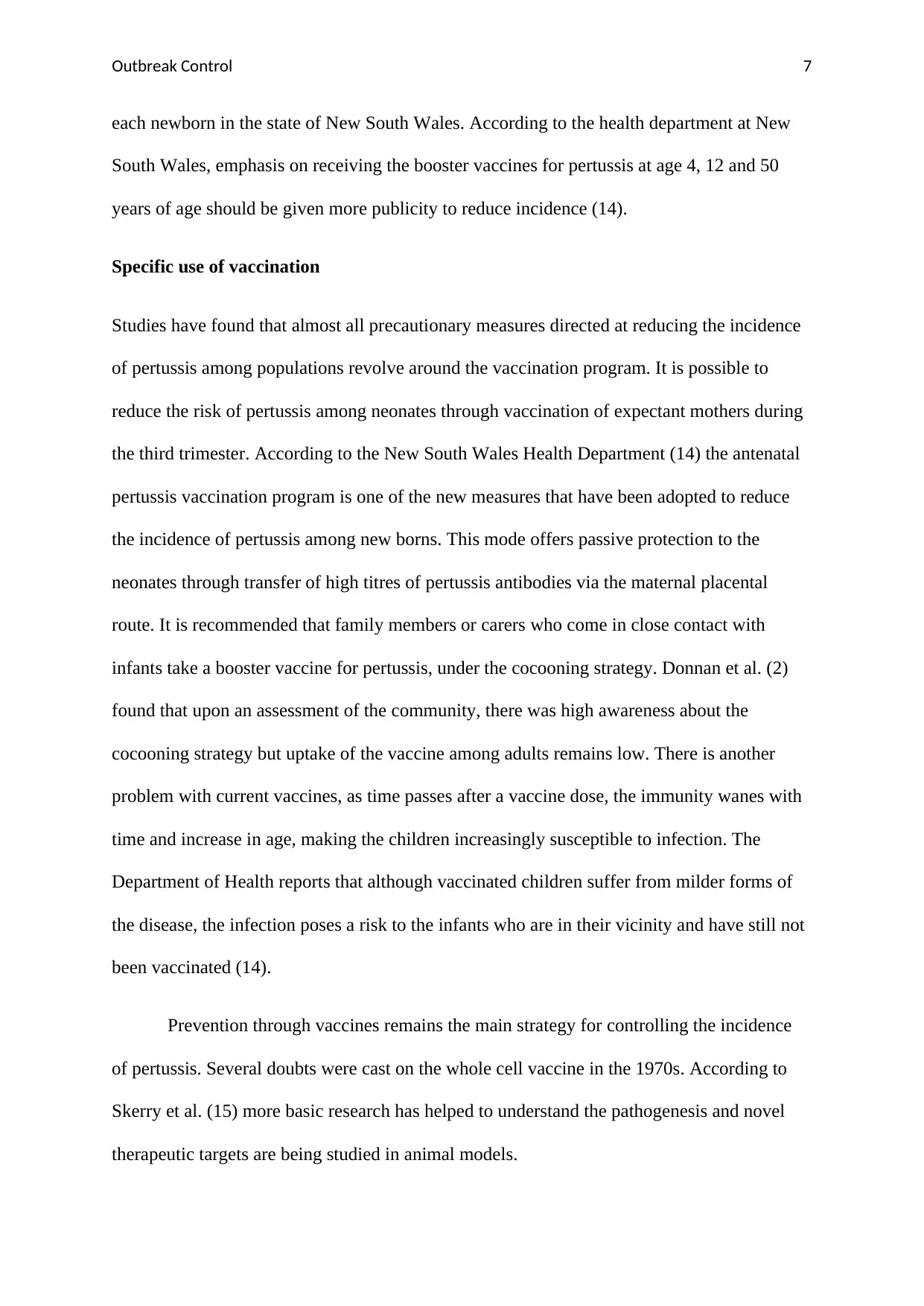
Outbreak Control 7
each newborn in the state of New South Wales. According to the health department at New
South Wales, emphasis on receiving the booster vaccines for pertussis at age 4, 12 and 50
years of age should be given more publicity to reduce incidence (14).
Specific use of vaccination
Studies have found that almost all precautionary measures directed at reducing the incidence
of pertussis among populations revolve around the vaccination program. It is possible to
reduce the risk of pertussis among neonates through vaccination of expectant mothers during
the third trimester. According to the New South Wales Health Department (14) the antenatal
pertussis vaccination program is one of the new measures that have been adopted to reduce
the incidence of pertussis among new borns. This mode offers passive protection to the
neonates through transfer of high titres of pertussis antibodies via the maternal placental
route. It is recommended that family members or carers who come in close contact with
infants take a booster vaccine for pertussis, under the cocooning strategy. Donnan et al. (2)
found that upon an assessment of the community, there was high awareness about the
cocooning strategy but uptake of the vaccine among adults remains low. There is another
problem with current vaccines, as time passes after a vaccine dose, the immunity wanes with
time and increase in age, making the children increasingly susceptible to infection. The
Department of Health reports that although vaccinated children suffer from milder forms of
the disease, the infection poses a risk to the infants who are in their vicinity and have still not
been vaccinated (14).
Prevention through vaccines remains the main strategy for controlling the incidence
of pertussis. Several doubts were cast on the whole cell vaccine in the 1970s. According to
Skerry et al. (15) more basic research has helped to understand the pathogenesis and novel
therapeutic targets are being studied in animal models.
each newborn in the state of New South Wales. According to the health department at New
South Wales, emphasis on receiving the booster vaccines for pertussis at age 4, 12 and 50
years of age should be given more publicity to reduce incidence (14).
Specific use of vaccination
Studies have found that almost all precautionary measures directed at reducing the incidence
of pertussis among populations revolve around the vaccination program. It is possible to
reduce the risk of pertussis among neonates through vaccination of expectant mothers during
the third trimester. According to the New South Wales Health Department (14) the antenatal
pertussis vaccination program is one of the new measures that have been adopted to reduce
the incidence of pertussis among new borns. This mode offers passive protection to the
neonates through transfer of high titres of pertussis antibodies via the maternal placental
route. It is recommended that family members or carers who come in close contact with
infants take a booster vaccine for pertussis, under the cocooning strategy. Donnan et al. (2)
found that upon an assessment of the community, there was high awareness about the
cocooning strategy but uptake of the vaccine among adults remains low. There is another
problem with current vaccines, as time passes after a vaccine dose, the immunity wanes with
time and increase in age, making the children increasingly susceptible to infection. The
Department of Health reports that although vaccinated children suffer from milder forms of
the disease, the infection poses a risk to the infants who are in their vicinity and have still not
been vaccinated (14).
Prevention through vaccines remains the main strategy for controlling the incidence
of pertussis. Several doubts were cast on the whole cell vaccine in the 1970s. According to
Skerry et al. (15) more basic research has helped to understand the pathogenesis and novel
therapeutic targets are being studied in animal models.
Paraphrase This Document
Need a fresh take? Get an instant paraphrase of this document with our AI Paraphraser
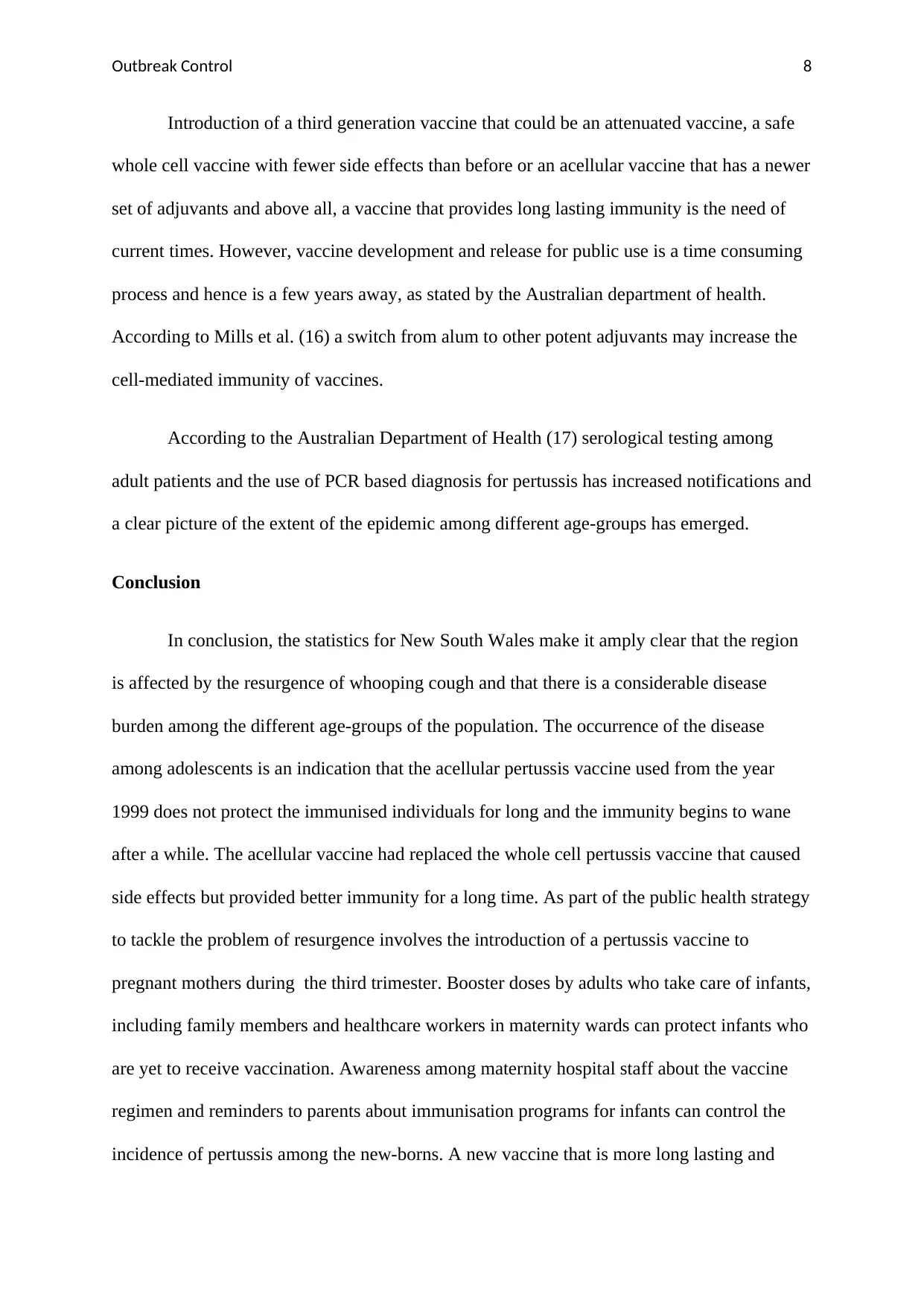
Outbreak Control 8
Introduction of a third generation vaccine that could be an attenuated vaccine, a safe
whole cell vaccine with fewer side effects than before or an acellular vaccine that has a newer
set of adjuvants and above all, a vaccine that provides long lasting immunity is the need of
current times. However, vaccine development and release for public use is a time consuming
process and hence is a few years away, as stated by the Australian department of health.
According to Mills et al. (16) a switch from alum to other potent adjuvants may increase the
cell-mediated immunity of vaccines.
According to the Australian Department of Health (17) serological testing among
adult patients and the use of PCR based diagnosis for pertussis has increased notifications and
a clear picture of the extent of the epidemic among different age-groups has emerged.
Conclusion
In conclusion, the statistics for New South Wales make it amply clear that the region
is affected by the resurgence of whooping cough and that there is a considerable disease
burden among the different age-groups of the population. The occurrence of the disease
among adolescents is an indication that the acellular pertussis vaccine used from the year
1999 does not protect the immunised individuals for long and the immunity begins to wane
after a while. The acellular vaccine had replaced the whole cell pertussis vaccine that caused
side effects but provided better immunity for a long time. As part of the public health strategy
to tackle the problem of resurgence involves the introduction of a pertussis vaccine to
pregnant mothers during the third trimester. Booster doses by adults who take care of infants,
including family members and healthcare workers in maternity wards can protect infants who
are yet to receive vaccination. Awareness among maternity hospital staff about the vaccine
regimen and reminders to parents about immunisation programs for infants can control the
incidence of pertussis among the new-borns. A new vaccine that is more long lasting and
Introduction of a third generation vaccine that could be an attenuated vaccine, a safe
whole cell vaccine with fewer side effects than before or an acellular vaccine that has a newer
set of adjuvants and above all, a vaccine that provides long lasting immunity is the need of
current times. However, vaccine development and release for public use is a time consuming
process and hence is a few years away, as stated by the Australian department of health.
According to Mills et al. (16) a switch from alum to other potent adjuvants may increase the
cell-mediated immunity of vaccines.
According to the Australian Department of Health (17) serological testing among
adult patients and the use of PCR based diagnosis for pertussis has increased notifications and
a clear picture of the extent of the epidemic among different age-groups has emerged.
Conclusion
In conclusion, the statistics for New South Wales make it amply clear that the region
is affected by the resurgence of whooping cough and that there is a considerable disease
burden among the different age-groups of the population. The occurrence of the disease
among adolescents is an indication that the acellular pertussis vaccine used from the year
1999 does not protect the immunised individuals for long and the immunity begins to wane
after a while. The acellular vaccine had replaced the whole cell pertussis vaccine that caused
side effects but provided better immunity for a long time. As part of the public health strategy
to tackle the problem of resurgence involves the introduction of a pertussis vaccine to
pregnant mothers during the third trimester. Booster doses by adults who take care of infants,
including family members and healthcare workers in maternity wards can protect infants who
are yet to receive vaccination. Awareness among maternity hospital staff about the vaccine
regimen and reminders to parents about immunisation programs for infants can control the
incidence of pertussis among the new-borns. A new vaccine that is more long lasting and
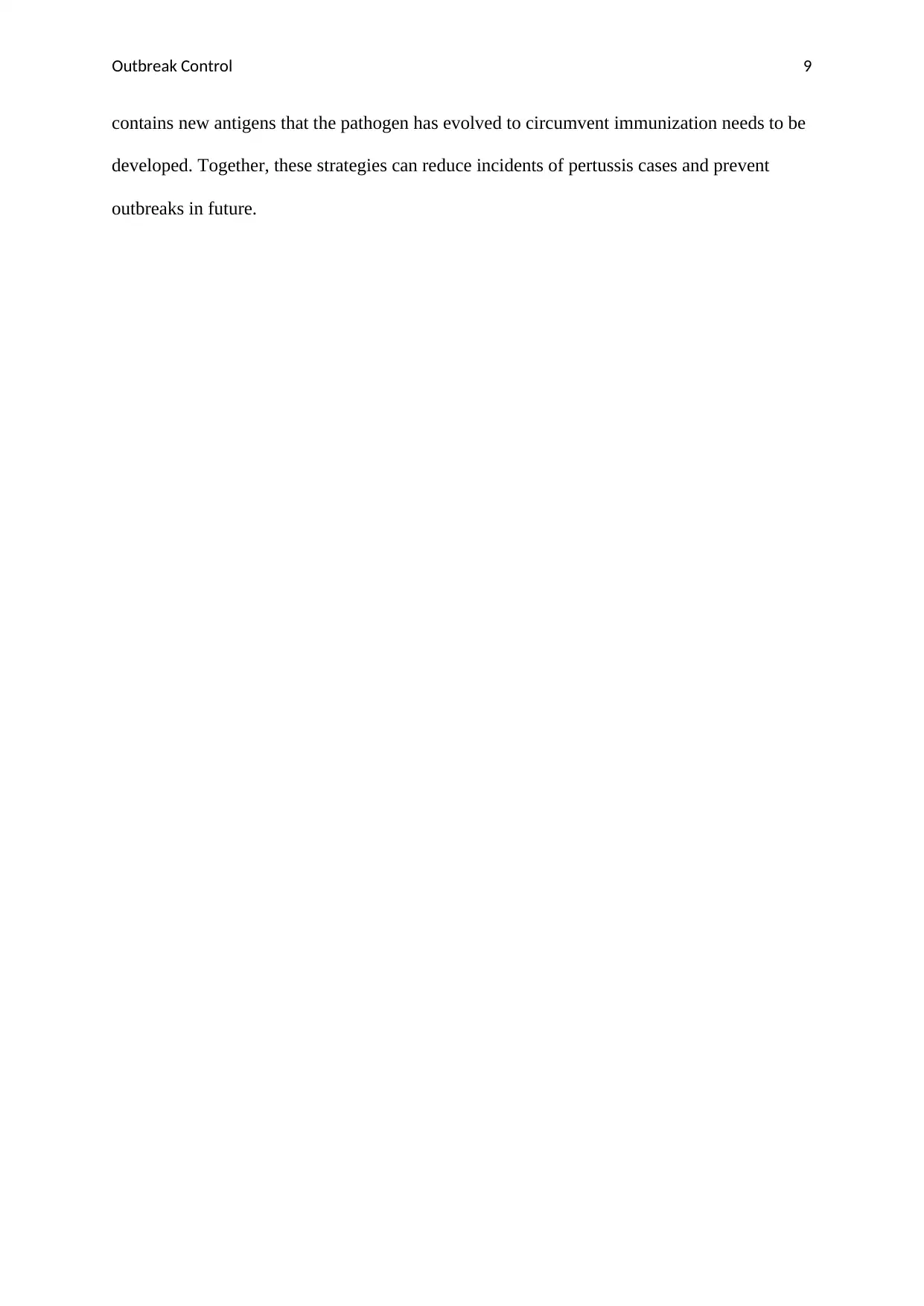
Outbreak Control 9
contains new antigens that the pathogen has evolved to circumvent immunization needs to be
developed. Together, these strategies can reduce incidents of pertussis cases and prevent
outbreaks in future.
contains new antigens that the pathogen has evolved to circumvent immunization needs to be
developed. Together, these strategies can reduce incidents of pertussis cases and prevent
outbreaks in future.
⊘ This is a preview!⊘
Do you want full access?
Subscribe today to unlock all pages.

Trusted by 1+ million students worldwide
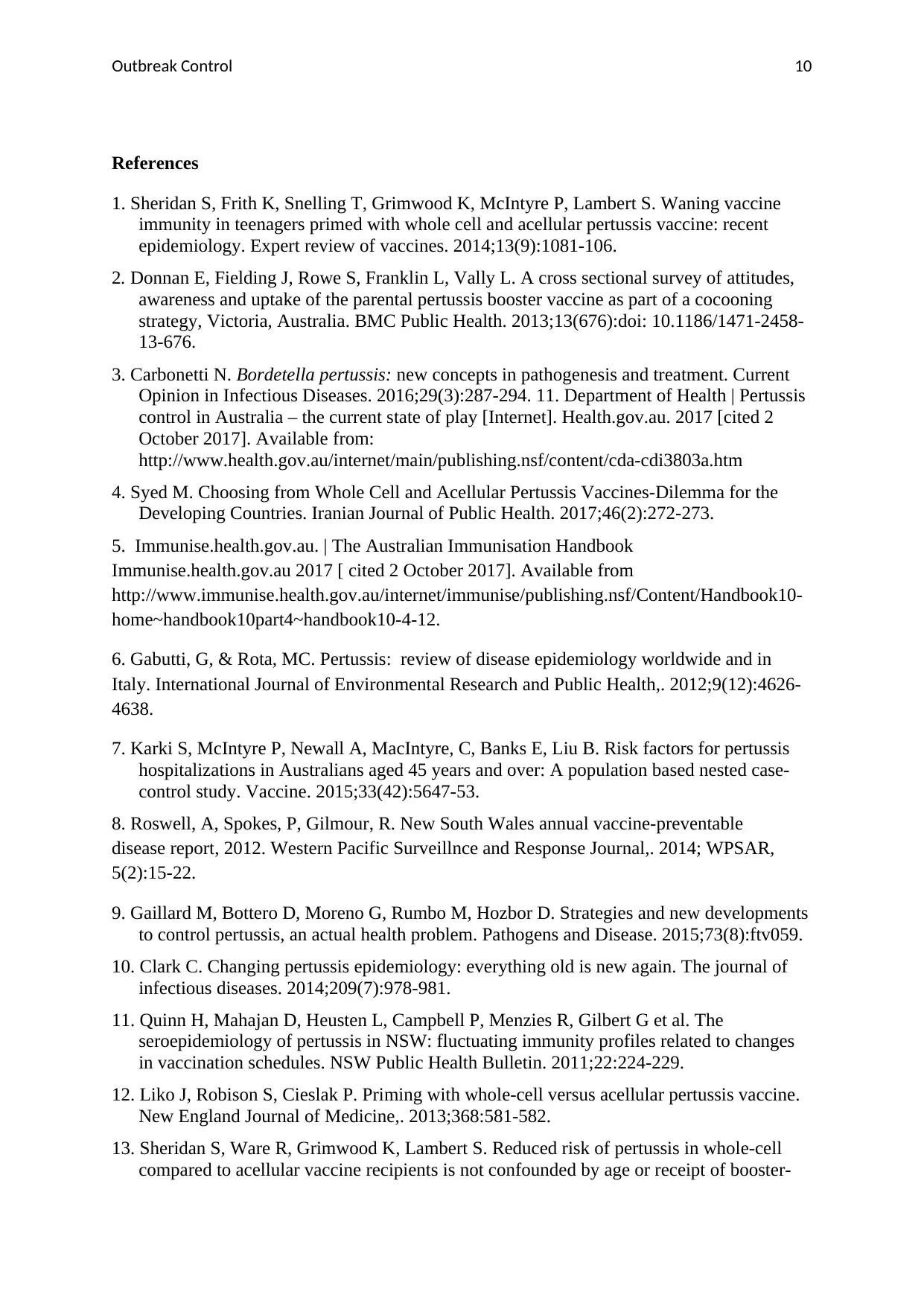
Outbreak Control 10
References
1. Sheridan S, Frith K, Snelling T, Grimwood K, McIntyre P, Lambert S. Waning vaccine
immunity in teenagers primed with whole cell and acellular pertussis vaccine: recent
epidemiology. Expert review of vaccines. 2014;13(9):1081-106.
2. Donnan E, Fielding J, Rowe S, Franklin L, Vally L. A cross sectional survey of attitudes,
awareness and uptake of the parental pertussis booster vaccine as part of a cocooning
strategy, Victoria, Australia. BMC Public Health. 2013;13(676):doi: 10.1186/1471-2458-
13-676.
3. Carbonetti N. Bordetella pertussis: new concepts in pathogenesis and treatment. Current
Opinion in Infectious Diseases. 2016;29(3):287-294. 11. Department of Health | Pertussis
control in Australia – the current state of play [Internet]. Health.gov.au. 2017 [cited 2
October 2017]. Available from:
http://www.health.gov.au/internet/main/publishing.nsf/content/cda-cdi3803a.htm
4. Syed M. Choosing from Whole Cell and Acellular Pertussis Vaccines-Dilemma for the
Developing Countries. Iranian Journal of Public Health. 2017;46(2):272-273.
5. Immunise.health.gov.au. | The Australian Immunisation Handbook
Immunise.health.gov.au 2017 [ cited 2 October 2017]. Available from
http://www.immunise.health.gov.au/internet/immunise/publishing.nsf/Content/Handbook10-
home~handbook10part4~handbook10-4-12.
6. Gabutti, G, & Rota, MC. Pertussis: review of disease epidemiology worldwide and in
Italy. International Journal of Environmental Research and Public Health,. 2012;9(12):4626-
4638.
7. Karki S, McIntyre P, Newall A, MacIntyre, C, Banks E, Liu B. Risk factors for pertussis
hospitalizations in Australians aged 45 years and over: A population based nested case-
control study. Vaccine. 2015;33(42):5647-53.
8. Roswell, A, Spokes, P, Gilmour, R. New South Wales annual vaccine-preventable
disease report, 2012. Western Pacific Surveillnce and Response Journal,. 2014; WPSAR,
5(2):15-22.
9. Gaillard M, Bottero D, Moreno G, Rumbo M, Hozbor D. Strategies and new developments
to control pertussis, an actual health problem. Pathogens and Disease. 2015;73(8):ftv059.
10. Clark C. Changing pertussis epidemiology: everything old is new again. The journal of
infectious diseases. 2014;209(7):978-981.
11. Quinn H, Mahajan D, Heusten L, Campbell P, Menzies R, Gilbert G et al. The
seroepidemiology of pertussis in NSW: fluctuating immunity profiles related to changes
in vaccination schedules. NSW Public Health Bulletin. 2011;22:224-229.
12. Liko J, Robison S, Cieslak P. Priming with whole-cell versus acellular pertussis vaccine.
New England Journal of Medicine,. 2013;368:581-582.
13. Sheridan S, Ware R, Grimwood K, Lambert S. Reduced risk of pertussis in whole-cell
compared to acellular vaccine recipients is not confounded by age or receipt of booster-
References
1. Sheridan S, Frith K, Snelling T, Grimwood K, McIntyre P, Lambert S. Waning vaccine
immunity in teenagers primed with whole cell and acellular pertussis vaccine: recent
epidemiology. Expert review of vaccines. 2014;13(9):1081-106.
2. Donnan E, Fielding J, Rowe S, Franklin L, Vally L. A cross sectional survey of attitudes,
awareness and uptake of the parental pertussis booster vaccine as part of a cocooning
strategy, Victoria, Australia. BMC Public Health. 2013;13(676):doi: 10.1186/1471-2458-
13-676.
3. Carbonetti N. Bordetella pertussis: new concepts in pathogenesis and treatment. Current
Opinion in Infectious Diseases. 2016;29(3):287-294. 11. Department of Health | Pertussis
control in Australia – the current state of play [Internet]. Health.gov.au. 2017 [cited 2
October 2017]. Available from:
http://www.health.gov.au/internet/main/publishing.nsf/content/cda-cdi3803a.htm
4. Syed M. Choosing from Whole Cell and Acellular Pertussis Vaccines-Dilemma for the
Developing Countries. Iranian Journal of Public Health. 2017;46(2):272-273.
5. Immunise.health.gov.au. | The Australian Immunisation Handbook
Immunise.health.gov.au 2017 [ cited 2 October 2017]. Available from
http://www.immunise.health.gov.au/internet/immunise/publishing.nsf/Content/Handbook10-
home~handbook10part4~handbook10-4-12.
6. Gabutti, G, & Rota, MC. Pertussis: review of disease epidemiology worldwide and in
Italy. International Journal of Environmental Research and Public Health,. 2012;9(12):4626-
4638.
7. Karki S, McIntyre P, Newall A, MacIntyre, C, Banks E, Liu B. Risk factors for pertussis
hospitalizations in Australians aged 45 years and over: A population based nested case-
control study. Vaccine. 2015;33(42):5647-53.
8. Roswell, A, Spokes, P, Gilmour, R. New South Wales annual vaccine-preventable
disease report, 2012. Western Pacific Surveillnce and Response Journal,. 2014; WPSAR,
5(2):15-22.
9. Gaillard M, Bottero D, Moreno G, Rumbo M, Hozbor D. Strategies and new developments
to control pertussis, an actual health problem. Pathogens and Disease. 2015;73(8):ftv059.
10. Clark C. Changing pertussis epidemiology: everything old is new again. The journal of
infectious diseases. 2014;209(7):978-981.
11. Quinn H, Mahajan D, Heusten L, Campbell P, Menzies R, Gilbert G et al. The
seroepidemiology of pertussis in NSW: fluctuating immunity profiles related to changes
in vaccination schedules. NSW Public Health Bulletin. 2011;22:224-229.
12. Liko J, Robison S, Cieslak P. Priming with whole-cell versus acellular pertussis vaccine.
New England Journal of Medicine,. 2013;368:581-582.
13. Sheridan S, Ware R, Grimwood K, Lambert S. Reduced risk of pertussis in whole-cell
compared to acellular vaccine recipients is not confounded by age or receipt of booster-
Paraphrase This Document
Need a fresh take? Get an instant paraphrase of this document with our AI Paraphraser
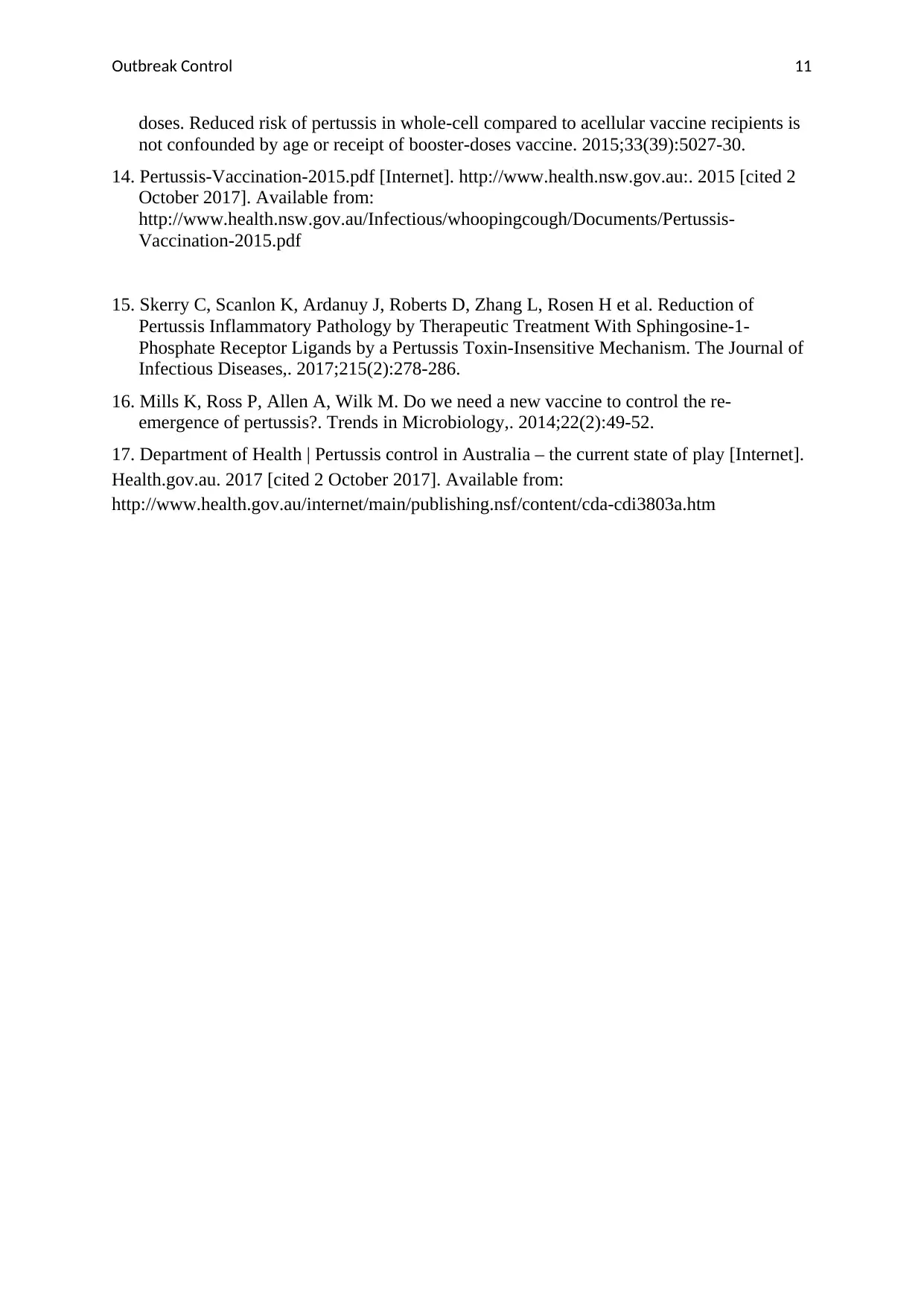
Outbreak Control 11
doses. Reduced risk of pertussis in whole-cell compared to acellular vaccine recipients is
not confounded by age or receipt of booster-doses vaccine. 2015;33(39):5027-30.
14. Pertussis-Vaccination-2015.pdf [Internet]. http://www.health.nsw.gov.au:. 2015 [cited 2
October 2017]. Available from:
http://www.health.nsw.gov.au/Infectious/whoopingcough/Documents/Pertussis-
Vaccination-2015.pdf
15. Skerry C, Scanlon K, Ardanuy J, Roberts D, Zhang L, Rosen H et al. Reduction of
Pertussis Inflammatory Pathology by Therapeutic Treatment With Sphingosine-1-
Phosphate Receptor Ligands by a Pertussis Toxin-Insensitive Mechanism. The Journal of
Infectious Diseases,. 2017;215(2):278-286.
16. Mills K, Ross P, Allen A, Wilk M. Do we need a new vaccine to control the re-
emergence of pertussis?. Trends in Microbiology,. 2014;22(2):49-52.
17. Department of Health | Pertussis control in Australia – the current state of play [Internet].
Health.gov.au. 2017 [cited 2 October 2017]. Available from:
http://www.health.gov.au/internet/main/publishing.nsf/content/cda-cdi3803a.htm
doses. Reduced risk of pertussis in whole-cell compared to acellular vaccine recipients is
not confounded by age or receipt of booster-doses vaccine. 2015;33(39):5027-30.
14. Pertussis-Vaccination-2015.pdf [Internet]. http://www.health.nsw.gov.au:. 2015 [cited 2
October 2017]. Available from:
http://www.health.nsw.gov.au/Infectious/whoopingcough/Documents/Pertussis-
Vaccination-2015.pdf
15. Skerry C, Scanlon K, Ardanuy J, Roberts D, Zhang L, Rosen H et al. Reduction of
Pertussis Inflammatory Pathology by Therapeutic Treatment With Sphingosine-1-
Phosphate Receptor Ligands by a Pertussis Toxin-Insensitive Mechanism. The Journal of
Infectious Diseases,. 2017;215(2):278-286.
16. Mills K, Ross P, Allen A, Wilk M. Do we need a new vaccine to control the re-
emergence of pertussis?. Trends in Microbiology,. 2014;22(2):49-52.
17. Department of Health | Pertussis control in Australia – the current state of play [Internet].
Health.gov.au. 2017 [cited 2 October 2017]. Available from:
http://www.health.gov.au/internet/main/publishing.nsf/content/cda-cdi3803a.htm
1 out of 11
Related Documents
Your All-in-One AI-Powered Toolkit for Academic Success.
+13062052269
info@desklib.com
Available 24*7 on WhatsApp / Email
![[object Object]](/_next/static/media/star-bottom.7253800d.svg)
Unlock your academic potential
Copyright © 2020–2025 A2Z Services. All Rights Reserved. Developed and managed by ZUCOL.





